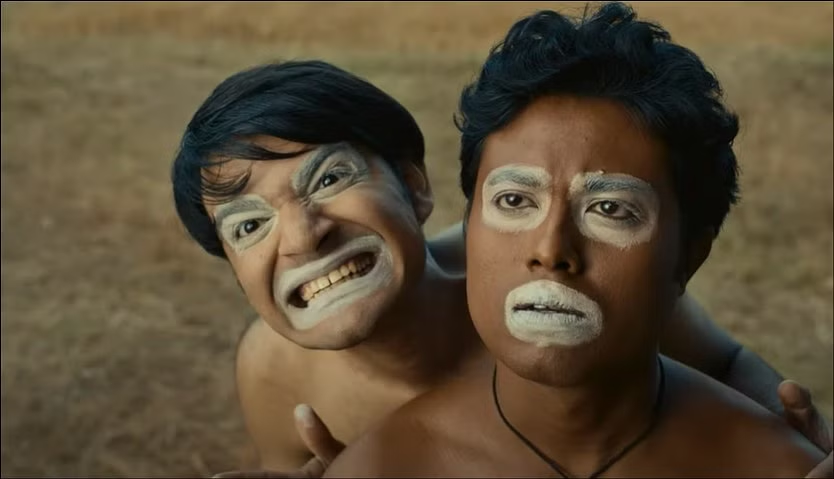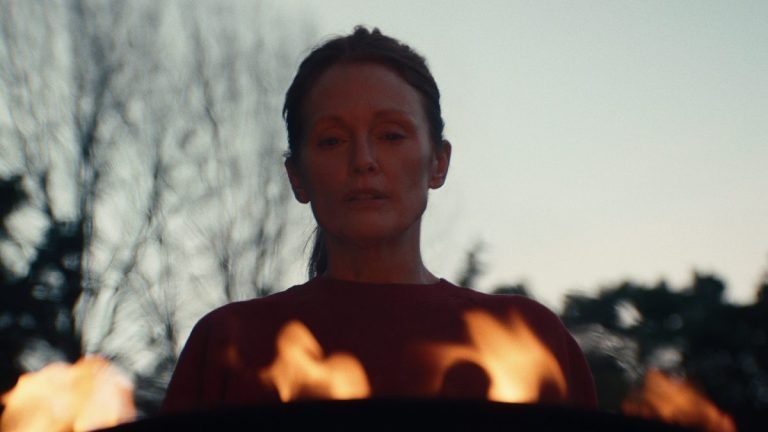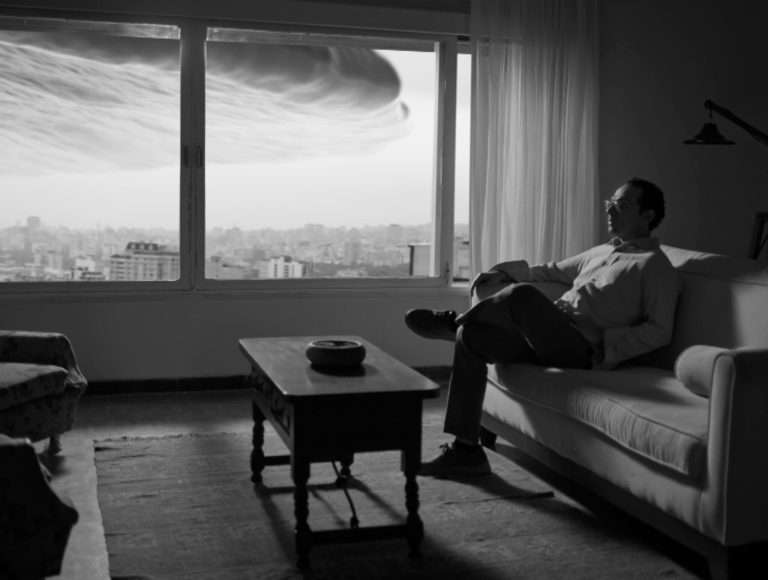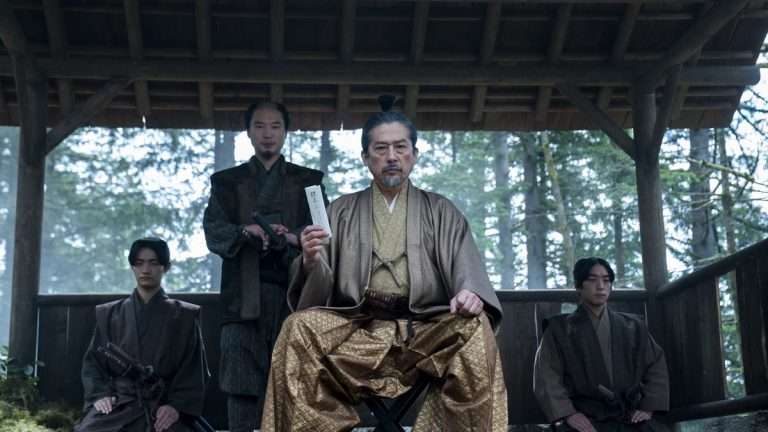A film adaptation of a theatre production, directed by the same director of the production, is always a double-edged sword. On the one hand, the new hand at film directing usually means that all inhibitions would be out of the window, and the director would try every trick in the playbook, even choosing to introduce newer tricks if one so chooses. On the other hand, over-stylization leading to over-direction becomes exhausting very quickly if the choices about the over-direction become a hindrance to a storytelling process that would have been more efficient if executed in a simpler fashion.
So is the case of “Athhoi,” which does feel like a straightforward adaptation of the theatre production that became massively popular in its five-year run. The primary distinction, if one can call it that, is not just set in a Bengali context (specifically related to caste) but also shifts the dynamics of the two primary characters of the movie: Athhoi (Othello) and Gogo (Iago). In this new dynamic, Athhoi and Gogo are both doctors but with widely divergent paths.
Gogo is a cancer researcher in New Jersey, while Athhoi is interested in establishing a healthcare center in his adopted village of Vinsura. By putting them at an even keel in an academic and professional case, the primary ethos of jealousy evolves from the caste divide between Gogo and Athhoi, and Gogo’s hatred acts as a slow poison. Not just because of the inherent casteism that governs almost all his actions, even the off-handed barbs always hint at the gratefulness that Athhoi should show, a form of servility that Gogo feels deserving of, rather than the respect and confidence with which Athhoi carries himself.

The over-direction at times works to its advantage, especially in the opening sequences. By making Gogo break the fourth wall, the movie chooses his traversal of the village of Vinsura to fill in the gaps in the childhood relationship between Gogo and Athhoi without taking up too much real estate. It’s smarter due to Anirban Bhattacharya’s performance of Gogo, where he evokes the slippery and performative nature of Iago with psychopathic tendencies. It is a classical, over-the-top performance, with Bhattacharya able to regulate it in most instances. But when your play and, consequently, the film are designed so much around the performative action of the Iago iteration, the over-the-top performance becomes almost happenstance and thus also tiresome.
Bhattacharya, as creative director, brings some of the flairs that are very familiar in a previous Shakespeare adaptation directed by him, “Mandaar.” Similar to “Mandaar,” the language utilized here is a strange mix of flowery and crass, delivered with a cadence that feels equivalently comforting for each actor. However, it’s the phonetic use of English, even liberally utilizing full sentences, that feels almost ill-matched in retrospect. The songs, being a curious mixture of lyrics as well as colloquialized iterations of the lines from the original Shakespearean play, render emotional potency strangely blunt.
The key difference between the stage adaptation of “Athhoi” and its film adaptation is a rather basic one: the cinematography. Soumik Halder brings such an exquisite use of colors in every frame, especially the shots at night, that even when the experimentation of the surroundings within the film, like all the lights around an open field (including moonlight), suddenly shut off and only the tent-like structure where Athhoi and Gogo are confronting each other is bathed in red light, the beauty of those frames manages to temporarily dissuade the feeling of a faux-intellectualism translating to a try-hard perspective. The decision to break the movie into distinctive chapters resembling slots within a cricket match (powerplay, slog overs, etc.) feels interesting.
But a gnawing discontent never goes away as the film progresses. With each instance of clever choice in the adaptation the film takes, it also chooses an equally flawed one. The inspiration for Vishal Bhardwaj’s “Omkara” is also readily apparent, down to an item number occurring just before the interval. However, unlike “Omkara,” the female characters in “Athhoi,” except for Diyamonti (Desdemona), aren’t fully developed or have any sort of agency.

Rather, they are treated as off-handed additions, both as plot points and characters. Diyamonti, on the other hand, has moments of confrontation with Athhoi as well as some genuine moments of dread with Gogo that produce some unique dynamics. However, this iteration of Cassio (Mukul), Rodrigo, or even Duke Barbantio is not developed exceedingly well. They aren’t given much of a specificity that would connect them to the milieu or a specified time frame. The leaning in over the visual flair and theatricality of the film also leads to the film becoming dragged out post-second half.
The fascinating flaw is in the character of Athhoi himself. Played by Arno, the director, Athhoi is inherently human—insecure in droves but also intellectually profound when calm. But there are instances of prudishness being shown that feel sort of misplaced. Athhoi managing to define the mind games that Gogo is playing with him (paranoid delusion) brings an added interesting wrinkle in introducing the possibility of an adaptation that might end with a redemption arc.
Of course, that doesn’t occur, but even introducing the kernel of an idea to a viewer deserves applause. But the movie’s choice in stoking the flames of jealousy, emerging the beast within, and pushing him to the plane of hatred by the characters listening to the atrocities around the world (global warming, the Israel-Hamas war, the increase in deaths of children due to obesity and malnutrition) feels strangely like lip service rather than being intricately woven into the narrative. I did like how the Dalit identity of the character of Athhoi is shown as such an integral part at the beginning of the film, especially in the wonderful opening monologue of Athhoi, but that too feels rather inconsistent as the movie progresses and even risks making what happens to Athhoi and the association of those actions through dream sequences feel cruel.
But if specificity begets universality, “Athhoi” is rather inconsistent in its specificity and thus fails to provide universality. Rather, the theatricality of the whole movie and the performances risk alienating the audience, leading to the film feeling more like a gorgeous-looking project than an emotionally devastating story. It becomes like a hodgepodge of “Othello” and “Omkara” through a Bengali lens that is also strangely out of focus.




![Personal Shopper [2017]: An Arc Waiting to be Completed](https://79468c92.delivery.rocketcdn.me/wp-content/uploads/2017/04/personal-shopper-pic-768x433.jpg)




